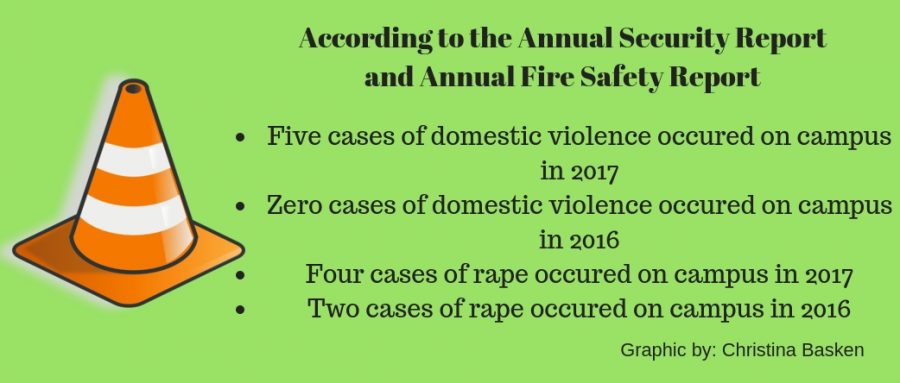UWO annual security report releases statistics on campus burglaries, sexual assaults, substance and alcohol use
Burglaries on campus and in student housing increased about 86 percent from 2016 to 2017, according to the Annual Security and Fire Safety Report released by the University Police Department on Sept. 24.
UP Capt. Chris Tarmann said on-campus burglaries are similar to off-campus burglaries because the cause is usually due to doors being left unlocked.
“Someone will leave their room and they’ll go to the bathroom and they’ll be in the bathroom for 15 or 20 minutes and they’ll come back to discover that somebody was in their room that shouldn’t have been in there,” Tarmann said. “Or they leave their room thinking that their roommate’s at the bathroom, and then they go to class and they find out their roommate actually went to class too and now their room is open.”
Sophomore Cal Swearingen lives in Horizon and said he hasn’t dealt with burglaries yet.
“There is always an influx of people coming in and out of our room, so I can see why it’d be an issue and how someone could easily walk in and take stuff,” Swearingen said. “I can see why it probably happens a lot.”
Tarmann said the UP developed the “Busted” initiative last year, where Community Service Officers go through hallways to check if doors are unlocked, and if nobody is in there they leave a “busted” card in their room.
“It basically just says on there, ‘Hey, we found your door unlocked. Locking your door is the best way to prevent a burglary, even if you’re going to only be gone for a few minutes, please take the time to lock your door. If we could have broken into your place, so could a criminal,’” Tarmann said.
Tarmann said oftentimes when there’s a burglary on campus, it’s one person that commits several acts during a single time frame.
From 2016 to 2017, a 75 percent increase in rape offenses and a 75 percent decrease in dating violence was also reported on campus or in residence halls. Five cases of domestic violence occurred in 2017 while none were reported in 2016.
“It’s hard,” Tarmann said. “I think we average somewhere around one to 15 assaults every year and I have to look specifically at our numbers to figure out what they are. But that’s just the police department, I’m not talking about Dean of Students or the Health Center or the Counseling Center getting those reports.”
Tarmann said the University has worked to redevelop the Title IX website to provide information and assist in reporting a sexual assault, which also can be found on the UWO Mobile App.
“I can say that the development of resources and pushing out information to our campus in appropriate ways and giving people more access to that should actually raise the number of sexual assault reports,” Tarmann said. “Because we know that sexual assault crimes are usually very low in reporting, and so if we can give access to people [to] that information, then they’ll actually report more incidents. Even though it’s not necessarily that more incidents are occurring, it’s that we are giving resources on how to report those incidents.”
Liquor law violations decreased 34 percent from 2016 to 2017. Despite the decrease of liquor law violations, the report presented a 77 percent increase in drug use violation arrests. However, disciplinary actions for drug use violations were 24 percent lower compared to previous years.
“I think our drug crimes are trending up a bit, and I think it’s related to marijuana charges,” Tarmann said. “We did do some re-evaluation on how we manage those, but we are not doing anything differently on how we charge or refer those cases. I think our society is changing; there’s states now that are legal, and it’s interesting how that has an impact on Wisconsin where it’s still illegal.”
UWO junior Austin Sackett said he believes substance use isn’t as common in the residence halls as it is off campus.
“I can see how going off campus to house parties and stuff might have a more prevalent problem,” Sackett said.










